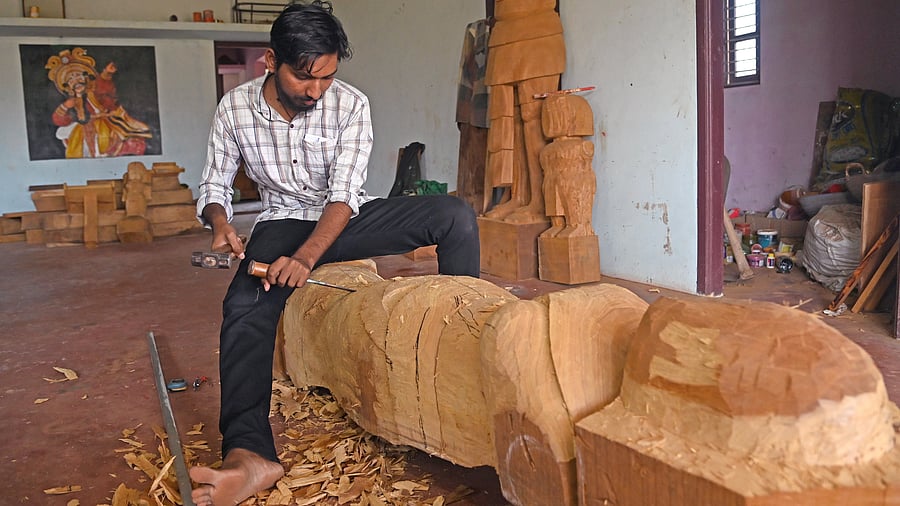
Pratheek works on a statue.
Credit: DH photos by Fakruddin H
Pratheek Gudigar and his assistant Chandraiah Achar are busy chiselling a massive wooden block, carefully shaping it into a majestic six-foot statue of Chennaya, the legendary hero of Tulu Nadu. A statue of Koti, another legendary hero, is also a work in progress. Each stroke of their chisels reveals intricate details, bringing the image to life with precision and artistry.
The rhythmic sound of carving fills the workshop at Ankadakatte near Koteshwara in Udupi district as they work diligently, ensuring every curve honours the legacy of the twin heroes of Tulu Nadu.
These wooden statues are being crafted for the Beladi Garodi in Udupi district, in time for the annual fair in April.
Pratheek was born into the Gudigar family, which has been engaged in carving wooden statues of deities for generations. Although he is an engineering graduate, the sudden passing of his father Pradeep Gudigar during the pandemic changed his course. While still pursuing his degree, he decided to honour the family’s legacy and complete the pending wooden statue orders his father had received from four kshetras.
"Had I not continued the legacy, the tradition would have ended with my father," says Pratheek. "Since I had a basic understanding of statue-making, it was not difficult for me to take on the tradition. Additionally, two of the artists who assisted my father continue to work with me. A newcomer would find it challenging to work on these wooden statues, as each has distinct features," he adds.
Since 2021, he has carved over 70 wooden statues for 48 kshetras. “We also clean and paint the wooden statues in the temples. The busy season is typically from January to May, as the demand for idols increases due to annual temple festivals,” Pratheek says. These wooden idols — commonly seen in Kundapura, Byndoor and Udupi — range from one foot to 15 feet in height.
Carving intricate profiles and painting a two-to-three-foot statue takes at least 10 to 15 days. “If the designs are highly detailed and complex, it takes even longer,” Pratheek explains.
The statues are made from either jackwood or wild jackwood. “All the wooden idols are characterised by their bright red, yellow and black colours. Over a period of time, the natural colours have been replaced with oil paints. One unique feature of our idols is that they are carved from a single piece of wood, with no nails used anywhere — only the hands are added on,” he says.
Chandraiah, Pratheek’s assistant, says, "I have been working on wooden statues for the past seven years. Earlier, I was involved in boat-building work in Goa. It was Pratheek’s father who invited me to assist him during the Maranakatte temple fair, and I have remained dedicated to this craft ever since. There is a strong demand for wooden statues, polishing, and painting.”
Raghuram Shetty, hereditary managing trustee of Maranakatte Brahmalingeshwara temple, says, “The 650-year-old statue at Maranakatte Brahmalingeshwara Temple was replaced with a new one carved by Pratheek’s father Pradeep in 2013.”
Wooden idols at the Nandikeshwara temple in Mekkikattu, Udupi district, are also attributed to Pratheek’s family. Some of the old wooden statues from Mekkikattu can be found in the National Crafts Museum in New Delhi.
Writer Manjunath Kamath says, “Around 40 to 50 wooden statues that find their place in the museum in Delhi were actually repaired at the Mekkikattu temple in the early 1900s. However, in the early 1970s, these statues were replaced with new ones. It was Kamaladevi Chattopadhyay who worked with the union government to take all the old wooden statues to the museum in Delhi,” he adds.
Vibrant statues made by the team.
DH photos by Fakruddin H